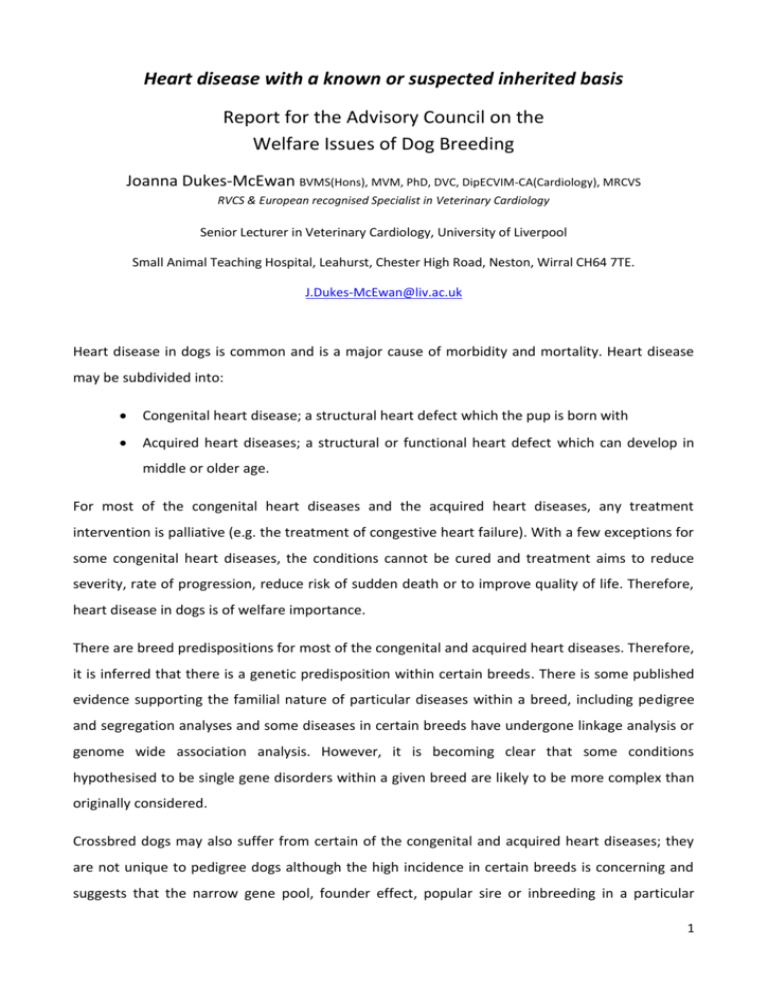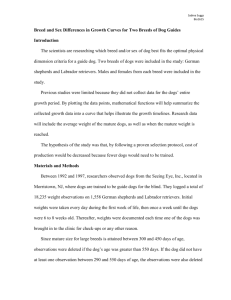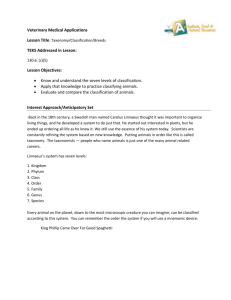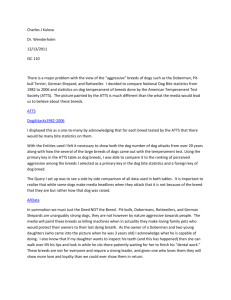Heart disease with a known or suspected inherited basis
advertisement

Heart disease with a known or suspected inherited basis Report for the Advisory Council on the Welfare Issues of Dog Breeding Joanna Dukes-McEwan BVMS(Hons), MVM, PhD, DVC, DipECVIM-CA(Cardiology), MRCVS RVCS & European recognised Specialist in Veterinary Cardiology Senior Lecturer in Veterinary Cardiology, University of Liverpool Small Animal Teaching Hospital, Leahurst, Chester High Road, Neston, Wirral CH64 7TE. J.Dukes-McEwan@liv.ac.uk Heart disease in dogs is common and is a major cause of morbidity and mortality. Heart disease may be subdivided into: Congenital heart disease; a structural heart defect which the pup is born with Acquired heart diseases; a structural or functional heart defect which can develop in middle or older age. For most of the congenital heart diseases and the acquired heart diseases, any treatment intervention is palliative (e.g. the treatment of congestive heart failure). With a few exceptions for some congenital heart diseases, the conditions cannot be cured and treatment aims to reduce severity, rate of progression, reduce risk of sudden death or to improve quality of life. Therefore, heart disease in dogs is of welfare importance. There are breed predispositions for most of the congenital and acquired heart diseases. Therefore, it is inferred that there is a genetic predisposition within certain breeds. There is some published evidence supporting the familial nature of particular diseases within a breed, including pedigree and segregation analyses and some diseases in certain breeds have undergone linkage analysis or genome wide association analysis. However, it is becoming clear that some conditions hypothesised to be single gene disorders within a given breed are likely to be more complex than originally considered. Crossbred dogs may also suffer from certain of the congenital and acquired heart diseases; they are not unique to pedigree dogs although the high incidence in certain breeds is concerning and suggests that the narrow gene pool, founder effect, popular sire or inbreeding in a particular 1 breed may increase incidence in contrast to the general canine population. There is no clear evidence that the Kennel Club breed standards or that external conformation factors play a role in susceptibility to a heart disease. However, there are some general conclusions such as small and toy breed dogs are more likely to develop congestive heart failure due to myxomatous degenerative valvular disease and that large and giant breed dogs may be more likely to develop dilated cardiomyopathy. Congenital heart diseases Patent ductus arteriosus (PDA) There is significant evidence that this has a genetic basis in certain breeds, although it is also seen in cross-breed dogs. It is more likely to occur in bitches than males and this sex predisposition is not evident in other heart diseases. The ductus arteriosus is a normal vessel in the foetus but after birth, it should close. If it does not, there is continuous shunting of blood between the aorta and the pulmonary artery, overloading the lungs and the left side of the heart, which eventually leads in most cases to congestive heart failure. It is very important to diagnose as early as possible since this is one of the few congenital heart defects which may be cured, by open chest surgery or minimally invasive key-hole procedures via catheterization. The outlook for affected dogs is much poorer if the diagnosis is made once they have developed congestive heart failure or the heart muscle function is adversely affected. Affected pups have a characteristic continuous murmur and the primary veterinary examination is very important for that pup and to advise the breeders to avoid breeding the sire and dam together again. Aortic stenosis This is one of the most common congenital heart defects in dogs. Either the aortic valve or the area beneath (or above) the valve is narrowed, so flow leaving the left ventricle into the aorta is fast and turbulent (giving a heart murmur) and there is a pressure load on the left ventricle. Although this is a congenital heart disease, lesions can progress after birth, so the heart murmur may increase as the pup grows. Aortic stenosis is prevalent in certain breeds, especially larger breeds. Heart testing schemes, based on cardiac auscultation, have been run by certain breed 2 clubs / councils in association with the Veterinary Cardiovascular Society. Dogs with louder heart murmurs have the more severe disease. These schemes are successful in that the number of pups with severe disease presenting to cardiologists have reduced. Because of the progressive nature of the lesions, the official heart testing should be when the dog is mature (12 months old). In some breeds, mild disease may not be detected and so Doppler echocardiography is used, and peak aortic flow velocity recorded (the faster the flow, the worse the stenosis). Dogs with severe aortic stenosis are at risk of exercise intolerance, syncope (fainting) and sudden death. There are no reliable treatment options. In contrast, some dogs may have only mild disease which does not affect their activity level, quality of life or life-span. There is evidence from at least one UK breed that selecting unaffected or mildly affected dogs for breeding by heart testing does reduce the proportion of severely affected dogs. Some dogs in breeds predisposed to aortic stenosis may also have narrower aortic roots than other dogs of similar body size although the significance of this is uncertain. Other congenital heart diseases Pulmonic stenosis is a narrowing of the pulmonic valve, or close to the valve, which obstructs flow leaving the right ventricle going to the pulmonary artery to the lungs. Again, heart murmur grade correlates with severity. This condition can be palliated in certain dogs (balloon valvuloplasty). However, in at least one breed, the condition may be associated with abnormalities of the coronary artery which mean that balloon dilation of the obstruction is not possible or is risky. Although there are well defined breed predispositions to pulmonic stenosis, the familial nature and mode of inheritance are unclear. No official heart testing schemes are currently run. The primary veterinary surgeon examining puppies therefore has an important role. Mitral and Tricuspid Dysplasia are congenital abnormalities of the mitral and tricuspid valves, usually resulting in incompetence of the valves. There are strong breed associations for both conditions and tricuspid dysplasia has been mapped by linkage analysis to chromosome 9 in one breed. Auscultation is reliable at detecting a heart murmur in mitral dysplasia, but it is less useful in tricuspid dysplasia. Ventricular septal defects are less common in dogs than other species, but they can still be associated with specific breeds. Very little is known about the genetic basis or inheritance of VSD, although there are some known candidate genes. 3 Acquired heart diseases Myxomatous degenerative valvular disease (MMVD) Myxomatous degeneration of heart valves can be regarded as a normal ageing process and the characteristic pathological changes can be recognised in any elderly dog of any breed or cross undergoing post-mortem examination. However, of particular concern is that this process occurs prematurely and progresses faster in small dogs in general, and certain breeds in particular. The degenerative changes predominantly affects the mitral valve (so the condition is also known as mitral valve disease), leading it to become incompetent and leaky (called mitral regurgitation), giving the characteristic heart murmur. This leads to volume overloading of the heart, and eventually pressures build up in the heart, resulting in damming back in the lungs (pulmonary oedema), leading to the signs of congestive heart failure (e.g. shortness of breath, coughing). Median survival time, even with optimised congestive heart failure treatment, is only 6 months after developing congestive heart failure signs. However, the time period from first detecting the heart murmur until the mitral regurgitation is severe enough to result in congestive heart failure may exceed five years. One breed in the UK in particular has attempted to address this problem by requiring annual heart testing (stethoscope), and avoiding breeding from dogs or bitches with premature onset of a heart murmur. However, rather than delaying breeding until dogs become elderly, the status of parents are also included prior to breeding. The age of onset does appear to have an inherited basis and a genome wide association study has identified loci within the genome which segregate between the cohort which are premature affected and the cohort with late onset disease. Dilated cardiomyopathy (DCM) Dilated cardiomyopathy is an acquired heart muscle disorder, where the heart fails as a pump. Pressures may build up in the heart, leading to fluid coming out of the circulation into the lungs (pulmonary oedema) or in to body cavities (ascites; free fluid in the abdomen, pleural effusion; free fluid in the chest cavity). Affected dogs often show marked exercise intolerance, weight and muscle loss and have severely compromised quality of life. Once congestive heart failure signs develop, even with optimised treatment, survival may only be weeks or months. This condition predominantly affects large and giant breeds of dog, with some exceptions (spaniel breeds); it is 4 rare in cross breed dogs. It has long been suspected to have a familial or genetic basis, which has been confirmed in some breeds. In most breeds, inheritance has been believed to be autosomal dominant, but recent work suggests that even in one breed, this is not a single gene disorder. In some breeds, the cardiomyopathy is associated with abnormal heart rhythms. Atrial fibrillation is an excessively fast heart rare which is common in large and giant breeds with CHF. In some giant breeds, it may precede any clinical signs or onset of congestive heart failure. Ventricular arrhythmias (e.g. ventricular tachycardia) are particularly common in certain breeds and are believed to be associated syncopal (fainting) episodes or even sudden cardiac death (presumed due to ventricular fibrillation). In certain breeds, sudden death is remarkably common, and it may be the first and only sign of a heart problem. Many experienced owners or breeders of these affected breeds may even regard it as “normal” that a dog may drop dead in middle or older age and may never inform their veterinary surgeon or request a post-mortem examination. Arrhythmogenic right ventricular cardiomyopathy (ARVC) is another specific form of cardiomyopathy affecting certain breeds. Screening for cardiomyopathy is not easy as this is an acquired disease and results of screening tests early on in the dog’s life may be completely normal. The disease evolves over years, as serial screening can identify, but results can be equivocal during this evolution. Screening includes echocardiography and 24 hour ambulatory ECG recording (Holter monitoring) in breeds at risk of arrhythmias. However, as the disease may not be manifested until the end of a breeding career, such testing does not always prevent transmission of disease to progeny. Conclusions In attempting to address the problem of both congenital and acquired heart diseases in dogs, the following need to be taken into account: 1) The importance of the primary veterinary examination prior to or after purchase of a puppy, so that both the new owner and the breeders can be suitably advised. 2) In breeds with high prevalence of a particular disease, the breed councils / clubs / societies have set up heart testing schemes, in association with the Veterinary Cardiovascular 5 Society. Heart testing by auscultation (use of a stethoscope) can identify most cases of congenital heart disease because of the presence of a heart murmur. One-off testing, as a puppy and once the dog is mature (e.g. 12 months old) identifies significant cases. MMVD can be similarly reliably identified by cardiac auscultation both by the primary veterinary surgeon and by cardiologists. However, this needs to be serially repeated through the dog’s life, e.g. annually. Dilated cardiomyopathy may have no auscultatory abnormalities and screening is far more complex and may include echocardiography, ambulatory ECG monitoring and blood testing, for cardiac biomarkers. This is costly and time consuming, especially as it also needs to be serially repeated. There was a move to the Kennel Club / British Veterinary Association taking over the umbrella of heart testing schemes although this has not been concluded so far. It has been difficult to include all breeds and all conditions on one form, and dealing with acquired heart diseases is always going to be problematic because of the need for repeat testing, e.g. annually. 3) There is still a lack of UK specific prevalence data for many of the breed associated problems. If breed clubs or the Kennel Club held records of morbidity / mortality data, true incidence of new cases per year could be monitored, and early action taken for new emerging problems or increasing numbers of cases. 4) The significant advances in canine genetics and the fact that dogs have many diseases of comparative importance to humans mean that we should aim to collect pedigree, DNA and phenotype data from dogs with various conditions and attempt to identify genes implicated with these conditions. If such genetic testing was shown to be reliable, then genetic screening of even acquired heart diseases may be possible and provide the breeder with an important tool in making decisions about breeding. References Available on request. 6






